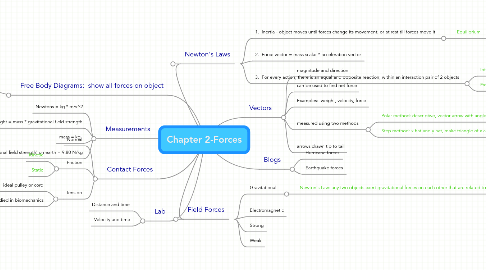Chapter 2-Forces
by Melissa Schultz


1. Measurements
1.1. Newtons = kg * m/s^2
1.2. Weight = mass * gravitational field strength
1.3. mass = kg
1.4. average g (gravitational field strength) on earth = 9.80 N/kg
2. Newton's Laws
2.1. 1. Inertia - object moves until forces change its movement, or at rest till forces move it
2.1.1. Equilibrium
2.1.1.1. moving at constant speed and direction
2.1.1.2. staying at rest
2.2. 2. Force vector = mass scalar * acceleration vector
2.3. 3. For every action, there is an equal and opposite reaction; within an interaction pair of 2 objects
2.3.1. Internal forces
2.3.2. External forces
3. Field Forces
3.1. Gravitational
3.1.1. Newton's Law: any two objects exert gravitational forces on each other that are related to distance and mass
3.1.1.1. F = G*m1*m2 / r^2
3.1.1.2. G = universal gravitational constant
3.2. Electromagnetic
3.3. Strong
3.4. Weak
4. Contact Forces
4.1. Normal
4.2. Friction
4.2.1. Kinetic
4.2.2. Static
4.3. Tension
4.3.1. ideal pulley or cord
4.3.2. typically studied in biomechanics
5. Free Body Diagrams: show all forces on object
5.1. can be drawn and measured using vectors
6. Lab
6.1. Distance and time
6.2. Velocity and time
7. Vectors
7.1. magnitude and direction
7.2. can be used to find net force
7.3. Examples: weight, velocity, force
7.4. measured using two methods
7.4.1. Polar method: descriptive, vector arrow with angle to horizontal
7.4.2. Step method: x hat and y hat, make triangle of x and y components, use SOH CAH TOA
